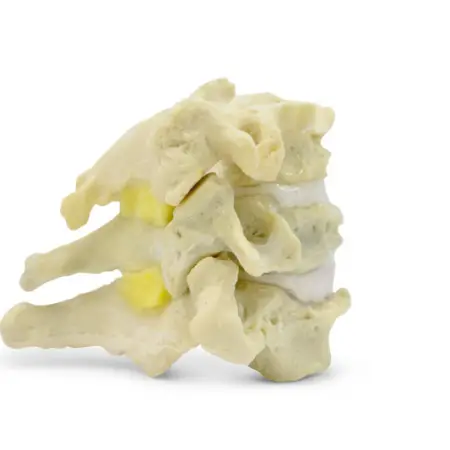Article reviewed and approved by Dr. Ibtissama Boukas, physician specializing in family medicine
What is the yellow ligament? We often hear about this ligament when we talk about hypertrophy of the yellow ligament, a sometimes serious and irreversible condition.
This article explains everything you need to know about this ligament, which is essential for the proper functioning of the spine.
Definition and anatomy
Also called "Ligamenta Flava" or "Ligamentum Flavum", the yellow ligaments are ligaments that extend between the laminae of the vertebrae of the spine. They are located throughout the spine (on both sides), from the C2 cervical vertebra to the S1 vertebra.
Each yellow ligament is about 5 mm thick. These ligaments are the thinnest in the cervical region, then become more and more thick as one reaches the dorsal region et lumbar.
The yellow ligaments are composed of 80% elastin fibers and 20% collagen fibers. It is the elastin fibers that give them their yellow color, as well as their elastic properties.
Function
As mentioned, the yellow ligament is unique in that it contains a significant proportion of elastin fibers. These elastic fibers therefore allow it to contract naturally, in a way. Therefore, it can help in the extension of the spine and the maintenance of upright posture.
In addition, the yellow ligaments prevent excessive flexion of the spine by their tension.
Finally, they provide posterior closure of the Spinal canal by their anatomical arrangement.
Yellow ligament hypertrophy
The yellow ligament can undergo degeneration with age, or after repeated trauma. In these circumstances, it loses elastic capacity, and increases in thickness.
These changes are most often located in the dorsal and lumbar spine, and can lead to calcium deposition in the ligament. These findings are usually seen on MRI or CT scans.
This calcification can thus cause the ligament to lose its elastic capacities, and lead to hypertrophy of the yellow ligament.
Due to hypertrophy, other related structures may become irritated, pinched or even compressed. We think in particular of the spinal cord and the emerging nerve roots.
This can lead to serious damage to the spine, such as a cauda equina syndrome, narrow lumbar canal, or a spinal cord compression.
If you have been diagnosed with yellow ligament hypertrophy and observe one of the symptoms mentioned in the following article, it is essential to consult quickly.
During certain types of surgeries (such as flavectomy, spinal decompression or laminectomies), sometimes a portion of the yellow ligament is removed.
My name is Anas Boukas and I am a physiotherapist. My mission ? Helping people who are suffering before their pain worsens and becomes chronic. I am also of the opinion that an educated patient greatly increases their chances of recovery. This is why I created Healthforall Group, a network of medical sites, in association with several health professionals.
My journey:
Bachelor's and Master's degrees at the University of Montreal , Physiotherapist for CBI Health,
Physiotherapist for The International Physiotherapy Center


